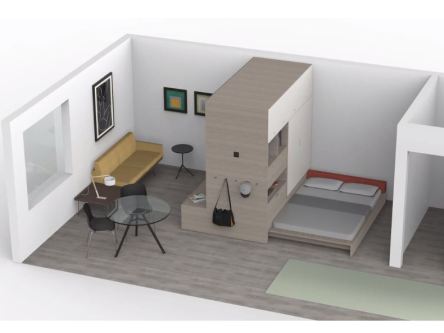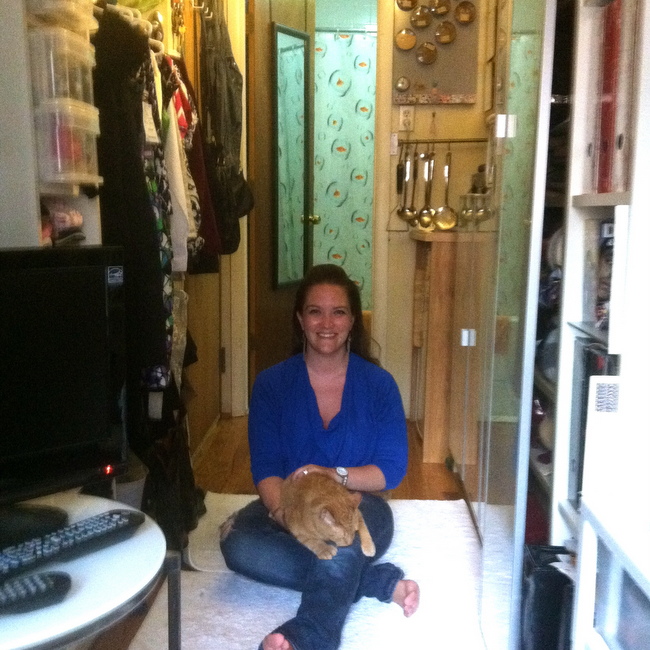Expandable furniture helps micro-apartment inhabitants make the most out of limited square footage with the push of a button. Trundle beds and convertible couches may define making the most of a small living space, but what’s been lacking is automation and modernization. Enter Ori, robotic furniture that appears, and disappears, with the push of a button. Modular Momentum The brainchild of Hasier Larrea, Ori furniture takes the guesswork out of transformation, seamlessly morphing floor units and wall installations into beds and pop-out closets. Ori offers a full-scale bedroom with a retractable bed that can be changed into an office or a closet, along with a full media console/credenza. Other versions include a walk-in closet, couch and various flavors of storage space. All the systems can be integrated into new and existing floorplans, which allows the Ori system to fit comfortably into any new building development or retrofit. During her tenure as the leader of the Architectural Robotics research area at the MIT Media Lab, Larrea married her robotics tech with Yves Behar design. The final product involves modular, transformable furniture Larrea and her team hope will debut early next year. “Larson’s team at the Media Lab developed the technologies behind Ori as part of the CityHome research,” Larrea told Mashable in a recent interview. “Then we created some initial functional prototypes … and went to [designer] Yves Béhar to help us ‘transform’ this initial concept from a robot/machine to a customizable system that people would love to have in their homes.” Space on Demand Ori’s first piece available for purchase includes a trundle style bed that rolls out from the bottom of a large wall of shelves. Specially designed actuators, electronics and software created by researchers at MITs CityHome project allows Ori’s furniture to almost...
The Shrinking House
Smaller is smarter
For Ryan Mitchell, the attraction of small-sized living hit home after a layoff. Despite an advanced degree and strong performance reviews, the Charlotte, N.C. man lost his job as a corporate recruiting consultant in 2008 due to the economic downturn, learning abruptly that “a job isn’t always a guaranteed thing, even if you’re a hard worker,” he said. The aftermath of the layoff led Mitchell not just to change his career path, but to reconsider how he’d live his life in the future. Now 27, the New Hampshire native works in non-profits, runs a successful blog, The Tiny Life, that focuses on small space living, and is about to custom build his own tiny house, which will be mobile. Immersing himself in the growing discussion and dialogue around living smaller and smarter has been eye-opening for Mitchell, and has revealed that he’s not the only one who wants to downsize. With a new job in the non-profit sector, he’s been saving up to build a house with a utility trailer as its foundation, so that in the future he can move anywhere for work if needed. He’s found that many of the visitors joining the discussion on The Tiny Life are retirees or soon to be retirees who are trying to figure out how to stretch their savings and retirement funds further. “Even if they have weathered the economic storm, they may have not saved enough, and life expectancy is so much longer now that money has to last longer. Retirees are trying to wrap their head around the question: ‘How am I going to have a good retirement with the money I have available and still have good quality of life?’” said Mitchell, whose highly-trafficked blog gets attention from around the world. One...
A Truly Tiny Apartment...
Living in 105 square feet
Take an average sized apartment and reduce it by 90 percent. Could you live there? With all the buzz in the news lately about micro-sized apartment living – particularly in markets like New York and San Francisco, where space is limited and renters will pay top dollar for even a closet-sized space to call home – we wanted to get the inside scoop. Literally, what is it really like to live in a teeny, tiny, itsy bitsy apartment? Is it sustainable? Does it drive you crazy? So we found Genevieve Shuler, who calls herself the Small Space Savant, to get our questions answered. For the last eight years, she’s called a 105 square foot “studio” in New York’s Greenwich Village her home sweet, albeit very small, home. Genevieve is a regular gal who like most of us owns a few extra pairs of shoes and loves her cat. She’s managed to make her micro living situation work with a few creative adaptations, like washing her dishes in the shower. Read on to find out more about how she functions in her pint-sized apartment. It’s inspiring insight for simplifying your life. She’s become a creative organization expert, even helping her friends and strangers create solutions for their own small spaces. TBS: What adaptations have you made to your life to make life in such a small space viable? GS: The biggest adaptation I’ve made in my life to make my small space work, is doing my dishes in the shower! I don’t have a kitchen sink, and my bathroom sink is too small to be practical for washing dishes, so my mother came up with the idea for me to do them in the shower. I have a corner shower caddy rack with those triangle...
Size Matters
Would you choose mansion or mini?
Imagine you’re on a game show – call it Real Estate Jeopardy – and have just been awarded a brand new home. The two prizes are behind unmarked doors – all you have to do is choose. (Drum roll please.) Behind door No. 1, you’ll find: A mansion modeled on the French Palace of Versailles. Located in Florida, this is the home featured on the film “Queen of Versailles,” which featured the Florida homes’ current owners, David and Jackie Siegel, and their opulent taste in size and design. It’s current on the market for $75 million – as is, unfinished – or $100 million, a price tag that includes finishing everything up before you move in. Take a look around on the house’s official sales video tour: Behind door No. 2., we have another residence that’s been in the news recently: an apartment that’s no bigger than a suite-sized hotel room. Maxing out at 300 square feet and being heralded as the solution for space-crunched cities like New York and San Francisco, micro-apartments are geared toward young professionals who want to work and play out in the city, not entertain at home. They’ll have a kitchenette, teeny-tiny bathroom, convertible furnishings and minimal storage space. Renters or owners will be simplifying their lives – and jettisoning possessions – before they move in. Some of these units are inspired by Airstream trailers, which define efficient mobile living. A look: The two extreme styles of living say a lot about America’s transition into a new housing economy. The Siegels had to stop work on their home due to the financial crisis, which made completing a 90,000 square foot place that has 10 Segways on site to get around a little less than feasible, even for a billionaire....




